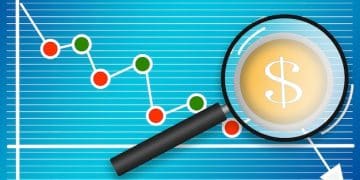Fed’s New Inflation Policy: 2025 Budget Impact Explained

The Federal Reserve’s new policy on inflation, prioritizing average inflation targeting, signifies a fundamental shift that could influence interest rates, borrowing costs, and investment strategies, directly affecting household and business budgets in 2025.
Understanding the implications of the New Federal Reserve Policy on Inflation: What It Means for Your 2025 Budget is crucial for individuals and businesses navigating the economic landscape. The Federal Reserve, often referred to as “the Fed,” plays a pivotal role in shaping monetary policy, which in turn influences everything from mortgage rates to employment figures. As we look towards 2025, the recent adjustments in the Fed’s approach to inflation control merit close attention, as they promise to ripple through various facets of the economy and profoundly impact financial planning.
Understanding the Federal Reserve’s Evolving Mandate
The Federal Reserve operates under a dual mandate from Congress: to achieve maximum employment and stable prices. For decades, “stable prices” was largely interpreted as maintaining a 2% annual inflation rate. However, recent economic shifts and persistent low inflation before the pandemic pushed the Fed to re-evaluate its strategy. This re-evaluation culminated in a significant policy change, moving from a strict 2% inflation target to an “average inflation targeting” approach.
This new framework acknowledges that periods of inflation below 2% will be tolerated, and even encouraged, to compensate for previous shortfalls. In simple terms, if inflation runs below 2% for an extended period, the Fed might allow it to rise moderately above 2% for some time to average out at the target. This subtle yet powerful shift has profound implications for how the Fed will conduct monetary policy and, consequently, for economic stability and growth.
The Shift to Average Inflation Targeting
The transition to average inflation targeting, announced in August 2020, marked a strategic evolution designed to anchor inflation expectations more firmly at 2%. Under the previous regime, if inflation consistently ran below the target, the Fed would still tighten policy preventatively once it approached 2%, effectively capping economic growth potential. The new system provides the Fed with greater flexibility to support the economy during downturns, allowing for a more sustained recovery and aiming for a stronger labor market.
This policy change is not merely technical jargon; it represents a conceptual recalibration of how the central bank perceives its role in managing the business cycle. By signaling its willingness to tolerate higher inflation temporarily, the Fed hopes to prevent premature tightening of monetary policy, fostering an environment conducive to full employment and sustained economic expansion.
- Increased Flexibility: The Fed can now allow inflation to exceed 2% for periods without immediately raising rates.
- Stronger Labor Market: Aims to achieve and maintain maximum employment by avoiding premature tightening.
- Inflation Expectations: Seeks to anchor long-term inflation expectations more firmly at the 2% average.
The rationale behind this shift is rooted in the lessons learned from the post-2008 financial crisis recovery, where inflation remained stubbornly low despite aggressive monetary easing. Policymakers realized that preventing inflation from persistently falling below target is as crucial as preventing it from running too high. The new framework is an attempt to address this asymmetry and provide a more robust response to future economic challenges, particularly those that might suppress inflation.
This nuanced approach implies that the Fed may keep interest rates lower for longer during economic recoveries, even as unemployment falls, as long as inflation has not consistently approached or exceeded the 2% average over time. This could mean a more gradual path to higher interest rates, impacting everything from consumer loans to corporate borrowing.
Impact on Interest Rates and Borrowing Costs
The Federal Reserve’s new inflation policy directly influences the trajectory of interest rates, which in turn dictate borrowing costs for consumers, businesses, and governments. With an averaged inflation target, the Fed is indicating a greater willingness to keep benchmark interest rates lower for longer, especially after periods where inflation has undershot its 2% goal. This has significant ramifications for anyone planning to take out a loan, finance a large purchase, or invest in interest-sensitive assets in 2025.
For consumers, lower interest rates generally translate into more affordable borrowing. This could mean lower mortgage rates, reduced costs for auto loans, and potentially cheaper personal loans and credit card interest. However, it also means lower returns on savings accounts and certificates of deposit (CDs), which could pinch those relying on fixed-income investments.
Mortgages and Housing Market
The housing market is particularly sensitive to changes in interest rates. A prolonged period of low rates, influenced by the Fed’s new policy, could continue to fuel demand by making mortgages more affordable. For prospective homeowners in 2025, this environment might present an opportunity to lock in historically low fixed-rate mortgages, reducing their monthly payments and overall cost of borrowing.
However, sustained low rates can also contribute to rising housing prices, potentially offsetting some of the affordability gains from lower mortgage costs. Current homeowners might find opportunities to refinance existing mortgages at lower rates, freeing up disposable income. The interplay between low rates and housing demand will be a key factor to watch when budgeting for housing-related expenses in the coming year.
- Affordable Mortgages: Lower interest rates can make homes more accessible.
- Refinancing Opportunities: Existing homeowners may benefit from lower monthly payments.
- Potential Price Appreciation: Increased demand could drive up housing values.
The housing market’s response to these policies is complex. While lower borrowing costs are generally favorable for buyers, the supply side of the equation also plays a crucial role. If new housing construction doesn’t keep pace with demand stimulated by low rates, prices could accelerate, creating different challenges for budget-conscious individuals.

This dynamic means that while the cost of financing might be lower, the initial capital required for a down payment could remain a significant barrier for many. Budgeting for a home in 2025 will therefore involve a careful balance of assessing mortgage affordability and the broader market conditions including inventory levels and price trajectories.
Credit Cards and Consumer Loans
Beyond mortgages, the Fed’s stance on interest rates extends to other forms of consumer credit. If the policy indeed leads to lower-for-longer benchmark rates, interest rates on credit cards and various personal loans might also remain relatively subdued. While credit card rates are often more volatile and influenced by individual credit scores, the prevailing federal funds rate provides a floor for these lending products.
For consumers with existing credit card debt, this could mean less upward pressure on variable interest rates, potentially making it easier to manage and pay down balances. For those considering new personal loans or financing other purchases, 2025 might offer a more favorable borrowing environment than in periods of aggressive rate hikes. However, it is always prudent to focus on responsible borrowing practices, regardless of the interest rate climate.
The impact on consumer loans isn’t uniform; some loans have fixed rates while others are variable. Those with variable rates are most susceptible to changes in the federal funds rate. Understanding the terms of your consumer loans and actively seeking out the best rates even in a low-interest environment will be key to optimizing your budget.
Inflation Expectations and Purchasing Power
The Federal Reserve’s new policy directly aims to influence inflation expectations. By explicitly stating its willingness to allow inflation to average 2% over time, rather than strictly capping it at 2%, the Fed hopes to prevent a deflationary spiral and encourage a healthier level of price increases. While this might sound academic, it has very real consequences for your purchasing power and budget planning for 2025.
If the Fed is successful in pushing inflation above 2% for a period, it means that the cost of goods and services will rise at a slightly faster pace. For consumers, this implies that your money might buy a little less over time. This erosion of purchasing power can be subtle, but it’s important to account for when planning long-term budgets and savings goals.
Cost of Goods and Services
A moderate increase in inflation, as targeted by the Fed, might lead to incremental price hikes across various sectors. Groceries, utilities, fuel, and other everyday essentials could see their prices trend upwards. While the Fed’s goal is to prevent runaway inflation, even a sustained rate slightly above 2% can add up over a year, impacting your disposable income.
Businesses, facing potentially higher input costs, may pass these on to consumers. This requires households to adjust their budgets to accommodate these rising expenses. Savvy budgeting in 2025 will involve re-evaluating spending habits and potentially seeking out more cost-effective alternatives if certain goods or services become significantly more expensive.
It’s important to differentiate between general price increases due to inflation and price increases due to supply chain issues or increased demand for specific products. The Fed’s policy addresses the former, aiming for a controlled and predictable rise in overall prices, rather than sudden spikes in individual sectors.
Wages and Income
On the flip side, the Fed’s intention to foster a stronger labor market and allow for higher inflation could, theoretically, lead to faster wage growth. If businesses are operating in an environment of mild inflation and strong demand, they may be more inclined to offer higher wages to attract and retain talent. For some, this could help offset the increased cost of living due to inflation.
However, wage growth doesn’t always keep pace with inflation, especially not for all sectors or demographics. The real impact on your budget will depend on whether your income rises at a rate equal to or greater than the rate of inflation. Budgeting for 2025 should therefore include an honest assessment of potential income adjustments versus anticipated changes in living costs.
- Inflationary Pressure: Expect gradual price increases for goods and services.
- Wage Growth Potential: Possible income increases, though not guaranteed to outpace inflation for everyone.
- Budget Adjustments: Essential to monitor spending and adjust for rising costs.
The “real value” of your savings, investments, and wages is what truly matters. If your investments or wages grow less than inflation, you are effectively losing purchasing power. This highlights the importance of not just what you earn and spend, but also how you save and invest.
Investment Strategies in a New Policy Climate
The Federal Reserve’s new inflation policy also has significant implications for investment strategies, particularly for those looking to grow their wealth in 2025 and beyond. A “lower for longer” interest rate environment, coupled with a willingness to allow inflation to exceed 2% for periods, shifts the attractiveness of different asset classes and requires investors to adapt their portfolios.
Traditional fixed-income investments, such as government bonds and high-quality corporate bonds, may offer lower real returns in an environment where inflation is allowed to run hotter. This means that the modest interest earned might be eroded by rising prices, diminishing the purchasing power of those returns. Investors typically look for instruments that can either generate higher nominal returns or provide inflation protection.
Equity Markets and Growth Stocks
In a low-interest-rate environment, equities (stocks) often become more attractive. When bond yields are low, investors tend to seek higher returns in the stock market. Growth stocks, in particular, may thrive as they are often more sensitive to lower discount rates applied to their future earnings projections. Companies with strong growth potential, which can raise prices without significantly impacting demand, may also be favored in an inflationary environment.
However, the narrative isn’t universally positive. Higher inflation can also lead to higher input costs for companies, potentially compressing profit margins. Investors will need to carefully analyze companies’ ability to manage these costs and pass them on to consumers. Sector-specific performance will vary, with some industries being more resilient to inflationary pressures than others.
Commodities and Real Estate
Commodities, such as gold, silver, oil, and agricultural products, are often considered a hedge against inflation. As inflation rises, the prices of these raw materials tend to increase, preserving their real value. Including a portion of commodities in an investment portfolio might provide some protection against the erosion of purchasing power. However, commodity markets are volatile, and their performance can be unpredictable.
Real estate is another asset class often viewed as an inflation hedge. Property values and rental income tend to increase with inflation, providing a natural buffer against rising prices. For real estate investors, 2025 might continue to be a good year if interest rates remain low and inflation moderately increases. However, the exact impact will depend on local market conditions, supply-demand dynamics, and the specific type of real estate investment.
- Fixed Income: May see reduced real returns due to inflation.
- Equities: Growth stocks often favored in low-rate environments, but cost management is key.
- Inflation Hedges: Commodities and real estate can offer protection against rising prices.
Diversification remains a cornerstone of prudent investment. Given the evolving monetary policy and its potential effects, investors should review their portfolios to ensure they are adequately diversified across various asset classes and that their risk tolerance aligns with their investment strategy. Consulting with a financial advisor to tailor these strategies to individual circumstances and goals is highly recommended.
Budgeting Strategies for Adapting to the New Reality
As the Federal Reserve’s new policy takes hold, adapting your budgeting strategies for 2025 becomes paramount. The shift to average inflation targeting and its implications for interest rates and purchasing power necessitates a proactive approach to managing your personal and business finances. This isn’t about panic, but about informed adjustments to ensure financial resilience and growth.
One of the most critical steps is to review and re-evaluate your current income and expenditure. Understand where your money is going and identify areas where potential cost increases due to inflation might impact you most. This detailed understanding forms the baseline for making strategic changes.
Managing Debt Effectively
In a potentially lower-for-longer interest rate environment, managing debt strategically is key. If you have high-interest variable-rate debt, such as credit card balances, consider prioritizing paying it down aggressively. While rates might remain low, they won’t stay there indefinitely, and reducing your principal debt offers certainty.
For mortgage holders, exploring refinancing options could reduce monthly payments and free up cash flow. However, weigh the closing costs against the potential savings. For those considering new debt, like a car loan or home equity line of credit, 2025 might be an opportune time to secure favorable fixed rates, locking in lower costs for the long term.
Savings and Emergency Funds
The erosion of purchasing power due to inflation means that simply letting money sit in standard savings accounts may not be the most effective strategy. While maintaining an emergency fund in an easily accessible, liquid account is crucial, consider whether excess savings could be deployed more strategically. This doesn’t mean taking on undue risk, but exploring options that offer returns above the inflation rate.
This could include inflation-protected securities (TIPS), certain types of certificates of deposit, or even a diversified investment portfolio suitable for longer-term savings goals. The goal is to ensure your savings are working for you, not losing value to inflation. Regularly review your emergency fund size to ensure it adequately covers a few months of living expenses, accounting for potential inflationary increases.
- Debt Prioritization: Focus on high-interest variable debt and explore refinancing.
- Strategic Savings: Look beyond traditional savings accounts for inflation-beating options.
- Emergency Fund Review: Adjust for potentially higher living expenses.
For businesses, managing cash flow becomes even more critical. Anticipate potential increases in supplier costs and labor expenses due to inflation and adjust pricing strategies accordingly. Maintaining healthy cash reserves and diversifying investment strategies for corporate funds will also be important to navigate the economic shifts of 2025.
Navigating Economic Uncertainties and Opportunities
The Federal Reserve’s new policy on inflation, while providing a clearer framework for monetary decision-making, does not eliminate economic uncertainties. In fact, by allowing inflation to run hotter for periods, it introduces new dynamics that both individuals and businesses must navigate. Understanding these nuances can help convert potential challenges into opportunities for growth and financial stability in 2025.
One key uncertainty revolves around the actual execution and market reaction to the averaged inflation targeting. While the Fed aims for controlled inflation, unforeseen economic shocks or supply chain disruptions could lead to more volatile price movements. Staying informed about economic indicators and global events will be essential for agile budgeting decisions.
Monitoring Economic Indicators
Regularly monitoring key economic indicators beyond just the headline inflation rate is crucial. This includes watching employment figures, consumer spending data, and manufacturing output. These indicators provide a more comprehensive picture of economic health and can offer early signals of shifts in inflationary pressures or economic growth trends.
For consumers, this means being more aware of news about supply chain movements, commodity prices, and sector-specific inflation. For business owners, keeping a close eye on producer price indices (PPI) and wage growth data can help anticipate rising operational costs and adjust business models proactively. Predictive analytics and staying current with reputable financial news sources will be invaluable.
Seeking Professional Financial Guidance
Given the complexity of monetary policy and its far-reaching effects, seeking professional financial advice can be a prudent step for many. Financial advisors can help individuals and businesses understand how the Fed’s policy might specifically impact their unique financial situation, from investment portfolios to retirement planning and debt management.
A personalized financial plan can help mitigate risks associated with inflation and interest rate fluctuations, while also identifying opportunities for wealth creation. This guidance can be particularly beneficial for long-term planning, ensuring that financial goals remain realistic and achievable amidst evolving economic conditions.
- Stay Informed: Monitor key economic indicators and global developments.
- Proactive Planning: Adapt budgets and financial strategies based on economic shifts.
- Expert Advice: Consult financial professionals for personalized guidance.
The economic landscape of 2025 will be shaped not only by the Federal Reserve’s policy but also by a multitude of global and domestic factors. While the new inflation framework offers a degree of predictability in terms of the Fed’s reaction function, the underlying economic currents will still require careful monitoring and adaptive strategies. Embrace awareness and flexibility in your financial approach.

Ultimately, successfully navigating the implications of the Federal Reserve’s new policy requires a blend of knowledge, foresight, and adaptability. Your budget for 2025 will be a living document, requiring periodic review and adjustment to reflect the ongoing shifts in the economic environment. By staying ahead of these changes, you can better position yourself to maintain financial stability and achieve your long-term goals.
Ensuring Financial Resilience in 2025
Building financial resilience in 2025, amidst the Federal Reserve’s new inflation policy, involves more than just reacting to economic changes; it requires a proactive and holistic approach to personal and business finance. The shift to average inflation targeting, while designed to foster economic stability, introduces variables that demand careful consideration and strategic planning. A robust financial plan will account for potential shifts in interest rates, the purchasing power of money, and investment returns.
At the core of resilience is a clear understanding of your financial position. This means regularly assessing your net worth, cash flow, and risk exposure. It also involves setting realistic financial goals that are adaptable to changing economic conditions. The ability to pivot and adjust your strategies will be a significant advantage in an environment shaped by evolving monetary policy.
Diversification Beyond Traditional Assets
In an era where traditional fixed-income investments might yield lower real returns due to inflation, considering diversification beyond conventional stocks and bonds could be beneficial. This might include exploring alternative investments, if appropriate for your risk profile, such as real estate investment trusts (REITs), private equity, or even carefully selected digital assets.
However, it is crucial to approach alternative investments with due diligence and a thorough understanding of their inherent risks. Diversification is not merely about holding many different things, but about holding assets whose returns behave differently under various economic scenarios, providing a buffer against declines in any single asset class.
Continuous Learning and Adaptation
The economic landscape is dynamic, and monetary policies, while foundational, are not rigid. The Fed itself adapts its strategies based on incoming data and evolving economic theories. Therefore, ensuring financial resilience means committing to continuous learning about economic trends, financial markets, and global events that can influence your financial well-being.
This includes reading reputable financial news, attending webinars, or even pursuing further financial education. The more informed you are, the better equipped you will be to anticipate changes, understand their implications, and make timely, effective adjustments to your budgeting and investment strategies. Financial resilience in 2025 will be a testament to your ability to learn and adapt.
- Holistic Financial Assessment: Regularly review net worth, cash flow, and risk exposure.
- Strategic Diversification: Consider a broader range of assets aligned with risk tolerance.
- Lifelong Financial Education: Stay informed and adapt strategies to economic changes.
Ultimately, the new Federal Reserve policy on inflation presents both challenges and opportunities for your 2025 budget. By understanding its mechanisms, preparing for its implications on interest rates and purchasing power, and cultivating a flexible, informed approach to financial management, you can enhance your financial resilience and navigate the future with greater confidence.
| Key Aspect | Brief Description |
|---|---|
| 🎯 Averaged Inflation Targeting | Fed tolerates temporary inflation above 2% to compensate for past shortfalls, aiming for a consistent 2% average. |
| 📉 Interest Rates | Likely kept lower for longer, impacting mortgages, loans, and savings returns. |
| 🛍️ Purchasing Power | Moderate inflation could erode value of money; budget adjustments are critical. |
| 📈 Investment Outlook | Favors equities and inflation hedges (commodities, real estate) over some fixed income. |
Frequently Asked Questions About the Fed’s New Policy
Average inflation targeting is the Federal Reserve’s new strategy where it aims for inflation to average 2% over time, explicitly allowing for periods where inflation runs moderately above 2% to make up for prior shortfalls. Previously, the Fed would tighten policy once inflation neared 2%, even if it had been persistently below target.
The Fed’s new policy suggests a “lower for longer” interest rate environment, which could mean mortgage rates remain relatively low in 2025. This could provide opportunities for prospective homeowners to secure affordable rates or allow current homeowners to refinance, though market conditions may vary.
Not necessarily. While the Fed might tolerate higher inflation, a “lower for longer” benchmark interest rate environment means traditional savings accounts and CDs are likely to continue offering modest returns. It encourages exploring inflation-beating investment options for long-term savings.
A sustained inflation rate slightly above 2% (as the Fed’s policy allows) means you can expect gradual price increases for everyday goods and services. This will impact your purchasing power, making it important to adjust your budget and monitor spending to account for rising costs.
In this environment, equities, particularly growth stocks and companies capable of passing on higher costs, may be favored. Commodities and real estate can act as inflation hedges. Fixed-income investments might yield lower real returns. Diversification and consulting a financial advisor are recommended to align investments with your risk tolerance.
Conclusion
The Federal Reserve’s new policy on inflation, transitioning to an average inflation targeting framework, marks a significant shift in monetary strategy with broad implications for the economic landscape of 2025. This deliberate move aims to provide greater flexibility in supporting the economy, fostering a stronger labor market, and anchoring long-term inflation expectations around an average of 2%. For your 2025 budget, this reorientation suggests a continued environment of potentially lower interest rates, which could influence borrowing costs for mortgages and consumer loans, creating opportunities for some while challenging traditional savings. Simultaneously, the Fed’s willingness to allow inflation to moderately exceed 2% for periods means a potential erosion of purchasing power, necessitating careful budgeting and a strategic review of investment portfolios to include assets that can hedge against inflation. Navigating this evolving economic reality effectively will require a proactive approach, continuous monitoring of economic indicators, adapting spending and saving habits, and potentially seeking expert financial guidance to ensure long-term financial resilience and prosperity.





